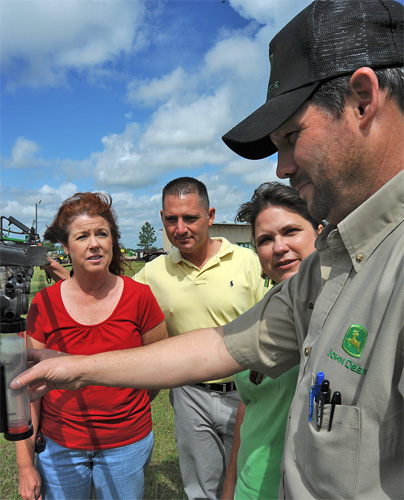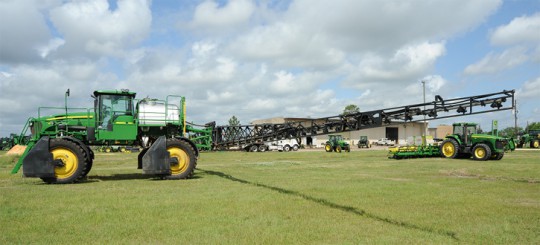Half Million Savings: Alabama, Florida Farmers Learn Chemical Control
July 11, 2013
Drive around the back roads near Atmore or Walnut Hill at this time of year, and you will see big fields planted in cotton and peanuts. Keep driving and odds are pretty good that you may drive between Florida and Alabama without ever realizing that you have crossed the state line.
Farmers in this area often work fields in both states. Row-crop production is big business in this area. Last year, more than 28,000 acres of cotton were grown in the two neighboring counties. Peanuts were planted in more than 30,000 acres in that same time period.
For cotton and peanut producers to run profitable operations, they have to manage closely all of their production inputs from seed to fuel.
Kim Wilkins, a row crops regional agent with the Alabama Cooperative Extension System, says agri-chemicals are the most expensive input farmers must buy.
“They use as little as they can to be effective because farmers just don’t have the money to waste,” says Wilkins.
Wilkins and her Florida Extension counterpart, Libbie Johnson, were looking for ways to help their farmers stay profitable when they came up with the idea of holding three agricultural sprayer workshops.
Johnson says it just made good sense to work together since many of the farmers have fields on both sides of the state lines. Wilkins agrees.
“In this area, we have farmers who work a lot of acres,” says Wilkins. “There is no way for them to be profitable in these crops without a lot of acreage. “
 Johnson says the pair took an idea that was being used successfully in south Florida and modified it to work with their growers.
Johnson says the pair took an idea that was being used successfully in south Florida and modified it to work with their growers.
“We knew that if we could get the growers to the meetings and help them calibrate their sprayers that we could help them reduce input costs,” says Johnson.
Sprayer calibration is a critical element for producers, says Wilkins.
“Apply too much, you risk crop injury and potential environmental impacts, and you have increased costs because of wasted product. Apply too little, you risk poor pest control, increased chemical costs because of product reapplications and reduced income from yield loss.”
Wilkins and Johnson enlisted the assistance of Smith Tractor Company and Hypro Sprayer Company. The sprayer workshops reached 60 farmers and included classroom presentations followed by sprayer tip evaluation demonstrations. During these demonstrations representatives from Alabama Extension, Florida Extension, and the companies would calibrate sprayers brought on site by farmers.
Wilkins says most of these sprayers have more than 60 tips, and each tip was evaluated using state-of-the-art calibration equipment.
“We then took the information from calibration testing and put it in a spreadsheet designed by Florida Extension. After doing some calculations, the spreadsheet advises whether producers should change their sprayer tips.”
Wilkins says a five percent reduction in total spray volume is a conservative assessment as a result of calibration changes made at the workshop.
Extension economists estimated that each of the 60 producers was farming an average of 1,000 acres so workshop participants as a group were working about 60,000 acres. According to the Gulf Coast Farm Analysis Association, the average cost of chemicals for peanuts and cotton is about $171. This means that workshop participants as a group saved more than $500,000 in input costs.
Johnson says producers appreciated how the workshops were set up.
“They appreciated that the meetings were held well in advance of planting times and that the meetings offered more than classroom instruction,” she says. “Being hands-on with farmers is still an important part of the county agent’s job. We are just doing hands-on work in ways that make the most of the technology available to us.”
Wilkins and Johnson add another benefit to partnering with industry is reaching new clients. Wilkins says that the workshops highlighted the quality of Extension programs to producers who have not been to many Extension programs.
Pictured top: A farm sprayer. Pictured inset: (L-R) Kim Wilkins, Billy Danielson, Libbie Johnson and Eddie Booker. Courtesy photos for NorthEscambia.com, click to enlarge.
Comments
4 Responses to “Half Million Savings: Alabama, Florida Farmers Learn Chemical Control”




To Mary:
“Are there any local cotton growers using organic methods?”
Yes, fertilizers are used on cotton, but alternative fertilizers are used by sprayers to cut down on cost due to large crops.
Are there any local cotton growers using organic methods?
I live up there and I am all for reduced spraying, no matter how its accomplished. Every year I get headaches and resperatory problems from the chemicals in the area. I know its nessasary, but I still hate it.
Calibrate that sprayer big Ed !!!!!!!!